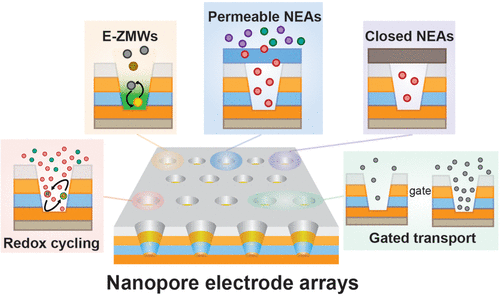当前位置:
X-MOL 学术
›
Acc. Chem. Res.
›
论文详情
Our official English website, www.x-mol.net, welcomes your feedback! (Note: you will need to create a separate account there.)
Single Entity Electrochemistry in Nanopore Electrode Arrays: Ion Transport Meets Electron Transfer in Confined Geometries.
Accounts of Chemical Research ( IF 18.3 ) Pub Date : 2020-01-28 , DOI: 10.1021/acs.accounts.9b00543 Kaiyu Fu 1, 2 , Seung-Ryong Kwon 3 , Donghoon Han 4 , Paul W Bohn 3, 5
Accounts of Chemical Research ( IF 18.3 ) Pub Date : 2020-01-28 , DOI: 10.1021/acs.accounts.9b00543 Kaiyu Fu 1, 2 , Seung-Ryong Kwon 3 , Donghoon Han 4 , Paul W Bohn 3, 5
Affiliation

|
ConspectusElectrochemical measurements conducted in confined volumes provide a powerful and direct means to address scientific questions at the nexus of nanoscience, biotechnology, and chemical analysis. How are electron transfer and ion transport coupled in confined volumes and how does understanding them require moving beyond macroscopic theories? Also, how do these coupled processes impact electrochemical detection and processing? We address these questions by studying a special type of confined-volume architecture, the nanopore electrode array, or NEA, which is designed to be commensurate in size with physical scaling lengths, such as the Debye length, a concordance that offers performance characteristics not available in larger scale structures.The experiments described here depend critically on carefully constructed nanoscale architectures that can usefully control molecular transport and electrochemical reactivity. We begin by considering the experimental constraints that guide the design and fabrication of zero-dimensional nanopore arrays with multiple embedded electrodes. These zero-dimensional structures are nearly ideal for exploring how permselectivity and unscreened ion migration can be combined to amplify signals and improve selectivity by enabling highly efficient redox cycling. Our studies also highlight the benefits of arrays, in that molecules escaping from a single nanopore are efficiently captured by neighboring pores and returned to the population of active redox species being measured, benefits that arise from coupling ion accumulation and migration. These tools for manipulating redox species are well-positioned to explore single molecule and single particle electron transfer events through spectroelectrochemistry, studies which are enabled by the electrochemical zero-mode waveguide (ZMW), a special hybrid nanophotonic/nanoelectronic architecture in which the lower ring electrode of an NEA nanopore functions both as a working electrode to initiate electron transfer reactions and as the optical cladding layer of a ZMW. While the work described here is largely exploratory and fundamental, we believe that the development of NEAs will enable important applications that emerge directly from the unique coupled transport and electron-transfer capabilities of NEAs, including in situ molecular separation and detection with external stimuli, redox-based electrochemical rectification in individually encapsulated nanopores, and coupled sorters and analyzers for nanoparticles.
中文翻译:

纳米孔电极阵列中的单实体电化学:在受限几何结构中离子传输遇到电子转移。
概述在密闭空间中进行的电化学测量提供了一种强大而直接的方法来解决与纳米科学,生物技术和化学分析之间的科学问题。电子传输和离子传输如何在有限的体积内耦合,如何理解它们需要超越宏观理论?而且,这些耦合过程如何影响电化学检测和处理?我们通过研究一种特殊类型的密闭体积结构,纳米孔电极阵列或NEA来解决这些问题,该结构的设计尺寸与物理定标长度(如德拜长度)相称,这种一致性提供了无法提供的性能特征在较大规模的结构中。这里描述的实验主要取决于精心构建的纳米结构,该结构可以有效地控制分子的运输和电化学反应性。我们首先考虑实验约束,这些约束指导了具有多个嵌入式电极的零维纳米孔阵列的设计和制造。这些零维结构几乎是探索如何将渗透选择性和未经筛选的离子迁移结合在一起以放大信号并通过实现高效的氧化还原循环来提高选择性的理想选择。我们的研究还强调了阵列的好处,即从单个纳米孔逸出的分子可被相邻的孔有效捕获,并返回到被测量的活性氧化还原物质的种群中,这是由于离子的积累和迁移耦合而产生的。这些用于操纵氧化还原物质的工具处于适当位置,可通过光谱电化学探索单分子和单粒子电子转移事件,而电化学零模式波导(ZMW)是一种特殊的混合纳米光子/纳米电子结构,其中下环为零,因此可以开展研究。 NEA纳米孔的电极既用作启动电子转移反应的工作电极,又用作ZMW的光学覆层。尽管此处描述的工作在很大程度上是探索性和基础性的,但我们相信NEA的发展将使重要的应用直接源自NEA独特的耦合传输和电子转移功能,包括原位分子分离和外部刺激检测,
更新日期:2020-01-28
中文翻译:

纳米孔电极阵列中的单实体电化学:在受限几何结构中离子传输遇到电子转移。
概述在密闭空间中进行的电化学测量提供了一种强大而直接的方法来解决与纳米科学,生物技术和化学分析之间的科学问题。电子传输和离子传输如何在有限的体积内耦合,如何理解它们需要超越宏观理论?而且,这些耦合过程如何影响电化学检测和处理?我们通过研究一种特殊类型的密闭体积结构,纳米孔电极阵列或NEA来解决这些问题,该结构的设计尺寸与物理定标长度(如德拜长度)相称,这种一致性提供了无法提供的性能特征在较大规模的结构中。这里描述的实验主要取决于精心构建的纳米结构,该结构可以有效地控制分子的运输和电化学反应性。我们首先考虑实验约束,这些约束指导了具有多个嵌入式电极的零维纳米孔阵列的设计和制造。这些零维结构几乎是探索如何将渗透选择性和未经筛选的离子迁移结合在一起以放大信号并通过实现高效的氧化还原循环来提高选择性的理想选择。我们的研究还强调了阵列的好处,即从单个纳米孔逸出的分子可被相邻的孔有效捕获,并返回到被测量的活性氧化还原物质的种群中,这是由于离子的积累和迁移耦合而产生的。这些用于操纵氧化还原物质的工具处于适当位置,可通过光谱电化学探索单分子和单粒子电子转移事件,而电化学零模式波导(ZMW)是一种特殊的混合纳米光子/纳米电子结构,其中下环为零,因此可以开展研究。 NEA纳米孔的电极既用作启动电子转移反应的工作电极,又用作ZMW的光学覆层。尽管此处描述的工作在很大程度上是探索性和基础性的,但我们相信NEA的发展将使重要的应用直接源自NEA独特的耦合传输和电子转移功能,包括原位分子分离和外部刺激检测,



























 京公网安备 11010802027423号
京公网安备 11010802027423号